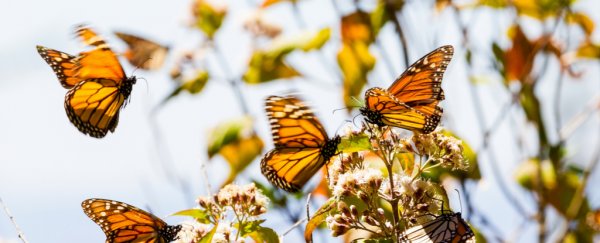A world-famous butterfly migration along the west coast of the US has reduced to a relative trickle in recent decades, indicating this amazing natural phenomenon could soon be a thing of the past.
The decline in western monarch populations has been evident since the 1980s. Now a new study is calling it; the end is nigh for this glorious butterfly.
Researchers from Washington State University working with communities along the coast of California pooled data on butterfly numbers from across the state to create a single estimate of the western monarch's numbers.
The news wasn't exactly optimistic – the population had declined to less than 5 percent of what it was about 35 years ago.
"In the 1980s, 10 million monarchs spent the winter in coastal California," says lead researcher Cheryl Schultz from Washington State University Vancouver.
"Today there are barely 300,000."
The western monarch (Danaus plexippus) has had a starring role in many nature documentaries of the mid-20th century, famous for accumulating in spectacular numbers that see entire trees and sections of woodland covered in a fluttery mass of striking black-and-orange wings.
These gatherings are the result of an annual autumn migration that sees them travel from all across the continent, down to the warmer climes of California's coast to spend time soaking up the sunshine.
Eastern populations – which are also in serious decline – move instead across the border into Mexico to wait out the winter chill.
These journeys are no small feat, with some numbers flying thousands of kilometres to arrive at their destination.
As the weather warms the butterflies head out to lay eggs on milkweed and feed from the spring flowers blooming across much of the west and mid-west, only to return as the temperature drops again.
In the 1990s, many nature lovers who had come to anticipate the vast swarms of butterflies started to notice their numbers were looking a little thinner each winter.
Unfortunately looks could be deceiving – the butterflies gather in groves of forest west of the Rocky Mountains, making it hard to tell if they're truly vanishing or just moving elsewhere.
Each Thanksgiving, the Xerces Society for Invertebrate Conservation has organised a count of the butterfly's numbers, producing a database that stretches back to 1997.
The researchers gathered together the data collected by volunteers across California since the 1980s and used a type of mathematical modelling to screen out the noise of fluctuations caused by minor year-to-year differences or changes to individual pockets of butterflies.
Not only does it look as if the numbers are a tiny fraction of what they were just a few decades ago, they're heading towards a critical point of no return.
"This study doesn't just show that there are fewer monarchs now than 35 years ago. It also tells us that, if things stay the same, western monarchs probably won't be around as we know them in another 35 years," says Schultz.
It isn't clear from the statistics alone what's responsible for the decline in butterfly numbers.
But most likely culprits include all the usual suspects; pesticides, land clearing, and climate change.
Future studies might help clear up exactly what's going on, but even if the cause is nailed, it's hard to tell if things are too late for the monarch.
"Scientists, policy makers and the public have been focused on the dramatic declines in the well-known eastern population, yet this study reveals that western monarchs are even more at risk of extinction," says biologist Emma Pelton from the Xerces Society.
"We will need significant conservation action to save monarch butterflies in the West."
The US Fish and Wildlife Service is paying attention, but its listing of the species as endangered would go a long way to help conservation efforts.
It'd be a shame if the only way future generations could experience the spectacle of trees seeming to shimmer with living fire is by watching it on YouTube.
This research was published in Biological Conservation.
